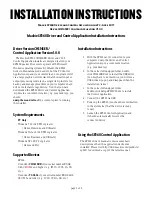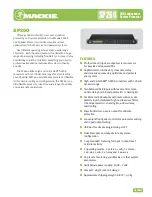
CMD-5xx 08/07/02
15
Data Link Controller / J1850
The CMD-5xx board provides a location to place a J1850 transceiver (Philips AU5780 or Harris HIP7010) for development of a
J1850 interface with the MPC565 Data Link Controller integrated peripheral. The board provides a DLC_IN input connector for
connection to the appropriate I/O port of the processor, a J1850 output connector for connection to the J1850 bus, and a termination
selection (T_LOW) option jumper.
DLC_IN Connector
Pin 1 = DLC TX input
Pin 2 = DLC RX output
Pin 3 = Transceiver Loop Back, active low will cause transceiver to loopback data for testing.
J1850 Connector
Pin 1 = +V from J1850 bus (vehicle battery), can be left disconnected if +12V supply is used for CMD-5xx board.
Pin 2 = J1850 signal
Pin 3 = Ground or common.
T_LOW Option Jumper
Open = High impedance termination (slave).
Installed = Low impedance termination (master).
CAN Interface and Options
The CMD-5xx board provides 3 CAN (TouCAN) transceivers with I/O ports: CAN_A, CAN_B, and CAN_C. All three ports are
supported by a Philips PCA82C250 1MBaud CAN transceiver. The CAN_A and CAN_B ports are directly interfaced to the host
MPC5xx controller's TOUCAN channels A and B. The CAN_C port is available for connection to MPC5xx controller I/O ports that
support a 3rd TouCAN channel but is not connected due to I/O port options associated with the 3rd channel. Following are the
options associated with the CAN ports:
CAN_A_EN, CAN_B_EN, and CAN_C_EN Option Jumpers
These option jumpers provide output enable and slew rate control of the respective transceiver. Installing the option jumper
(default) provides minimum slew rate (fast edge) and enables the output of the respective transceiver. Opening the option disables
transceiver output to the CAN bus. With the option jumper removed, Pin 2 of the option header can be connected by the user to an
available I/O port for software control of transceiver output (active low). Slew rate can be increased if necessary to reduce
switching noise by increasing the value of R22, R23, or R24 for the respective CAN port A, B, or C. See the PCA82C250 data
sheet for details.
CAN_A_RX and CAN_B_RX Option Jumpers
These option jumpers enable the receive connection from the CAN channel transceiver to the MPC5xx host controller CNRX0 I/O
pin. Installed by default, the options allow the isolation of the RX signals so that the user may use a different connection or
transceiver for the MPC5xx TouCAN port.
CAN_C_IN Connector
This connector provides the CAN C channel TX and RX signal to the transceiver. Depending on the MPC5xx in use, the respective
CAN_C_IN pin would be connected to the associated MPC5xx I/O pin providing the TouCAN channel C signals by the user.
Pin 1 = TouCAN C TX signal (pin closest to label of connector), MPC561/2/34 =MIOS Port pin 31, MPC565/6 = MIOS Port pin 32.
Pin 2 = TouCAN C RX signal. MPC561/2/3/4 = MIOS Port pin 30, MPC565/6 = MIOS Port pin 33.
CAN_A, CAN_B, and CAN_C I/O Port Connectors
These ports provide the CAN transceiver input and output connection to the CAN bus. No bias or termination for the CAN bus is
provided on the CMD-5xx board, if required the user must install these components in the proto area or elsewhere on the CAN bus.
Following are the pin connections for the ports:
Pin 1 = CAN-Hi level signal
Pin 2 = CAN-Lo level signal
Pin 3 = Ground or common (this is required for proper return path on CAN bus)
Pin 4 = +5Vsupply for remote use or bias of CAN bus.






































